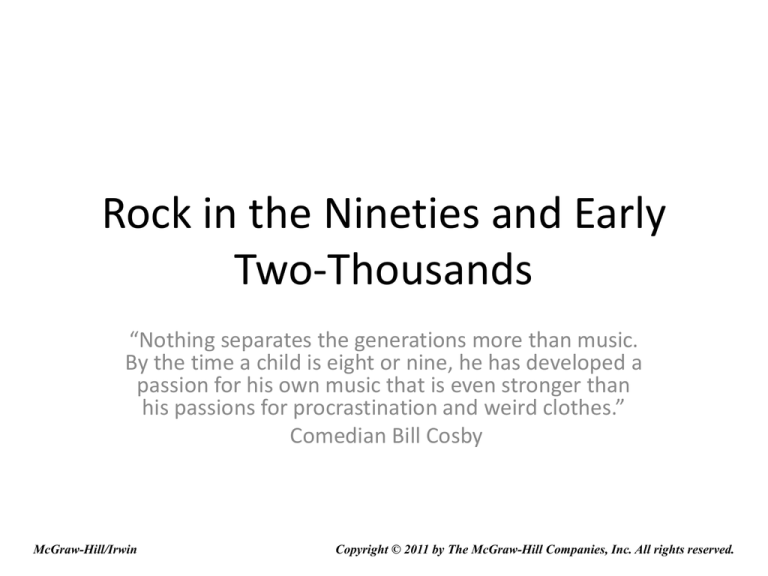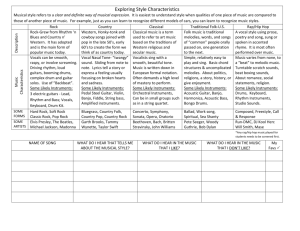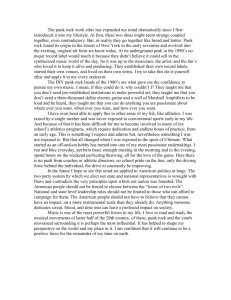
Rock in the Nineties and Early
Two-Thousands
“Nothing separates the generations more than music.
By the time a child is eight or nine, he has developed a
passion for his own music that is even stronger than
his passions for procrastination and weird clothes.”
Comedian Bill Cosby
McGraw-Hill/Irwin
Copyright © 2011 by The McGraw-Hill Companies, Inc. All rights reserved.
50th Birthday of Rock Music
Exactly when the birthday was, depends on
opinions about exactly when rock began
Late-forties rhythm and blues performances were
leading to the development of fifties rock
Rock was well established and gaining widespread
popularity by the early-to-mid fifties
Many styles of rock music to follow allowed for a
greater variety of music than ever to be available
today
Some of those diverse newer styles are the subject
of this last chapter
21-2
Grunge Rock
Roots and influences:
Progressive-influenced punk rock by “no wave” band from New
York, Sonic Youth, invited early Seattle bands to play at
concerts
Seventies British heavy metal vocals and guitar/bass riffs and much
distortion
Punk intensity and noise level
“Grunge” title from loud crunch of guitar sounds
Early Seattle bands:
Soundgarden
Mudhoney
Nirvana
Pearl Jam
21-3
Listening Guide
“Smells Like Teen Spirit” by Nirvana (1991)
Tempo: 116 beats per minute, 4 beats per bar
Form: 12-bar instrumental introduction, then 16-bar verses or choruses with some 4-bar instrumental
introductions
The 3rd verse is instrumental
The recording ends with nine repetitions of the words “A denial!” and then a fade out
Features: The first 3-bars of the introduction are played by a strummed acoustic guitar
Drums enter at bar 4, and fuzztone electric guitar and electric bass guitar come in at the 4th beat of
bar 4
The instruments play a riff pattern that changes pitch as the chords change
The 4-bar introductions to verses are somewhat subdued, with a strong backbeat in drums, and the
bass playing repeated notes on the half-beats
During the instrumental verse, a fuzztone electric guitar plays the verse melody
Cobain’s vocals are sometimes sung in a melancholy mood and other times screamed.
Lyrics: The lyrics are difficult to understand, but include statements of insecurity and a desire to be with
a group where one is accepted.
Charts: Pop, #6
21-4
Pop Punk
An outgrowth of more melodic punk by such bands as the Ramones in
songs like “Sheena Is a Punk Rocker”
Green Day formed in 1988, Oakland, CA
After two albums and tours, signed with Reprise Records, a move
disliked by hardcore fans, but brought band to mainstream
acceptance and a Grammy for Best Rock Album, Dookie (1994)
More political on American Idiot (2004) as anti Iraq-war concept
album
Other pop punk bands:
Rancid
The Offspring
Blink 182
21-5
Listening Guide
“When I Come Around” by Green Day (1994)
Tempo: 100 beats per minute, 4 beats per bar
Form: Structure based on repetitions of a 2-bar riff that only breaks during three
choruses
The riff repeats as an introduction, then vocals enter at the fourth repetition
Each of 2 verses is sung through eight repetitions of the riff
At each chorus, chords are held and the riff returns at “When I come around.”
Features: Instrumentation is guitar with heavy fuzztone, electric bass guitar, and
drums
Even beat subdivisions
Strong backbeat in drums
Vocals are almost monotone and the singer sounds quite bored
Lyrics: The singer is a promiscuous male who proudly announces he will only visit his
girlfriend at his convenience.
Charts: Pop #6
21-6
Emo
Roots and Influences:
Ian MacKaye’s bands Minor Threat, Embrace, and Fugazi – punk style with songs
that focused on healthy lifestyles
Straight Edge movement – rejection of drugs, alcohol, tobacco, irresponsible sex,
and, in many cases, eating meat
Songs eventually became nostalgic and confessional
Movement called “emotional hardcore,” then “emocore,” and finally, emo
Early Emo bands:
Embrace
Rites of Spring
Jawbreaker
Sunny day Real Estate
Later bands:
Jimmy Eat World
Dashboard Confessional
Fall Out Boy
21-7
Listening Guide
“The Middle” by Jimmy Eat World (2001)
Tempo: 160 beats per minute, 4 beats per bar
Form: 8-bar introduction, verses, and refrains, with a 16-bar instrumental in
the middle
Features: Instrumentation is voice, guitar, percussion, bass guitar, drums, and
“synth emulator”
Introduction has a guitar strumming on every half-beat and the bass softly
supporting the beat
Strong backbeat in drums that enter at the beginning of the first verse
Even beat subdivisions
Soft vocal responses repeat part of the text in some verses
Abrupt ending after final refrain
Lyrics: The lyrics encourage listeners to feel all right about themselves and
live as well as they can
Charts: Modern rock, #1, Hot 100, #5, British hits #26
21-8
Jam Bands
Musical term “jam” refers to musicians getting together to try things
out and play casually
Early and very long-lasting jam band – the Grateful Dead, concerts
casual without pre-controlled planning of song play lists or events
Psychedelic influences include long improvisations
Musical styles including country, jazz, blues, folk, and Latin rhythms
combined with rock
Phish – free-form concerts that combined folk, jazz, country, bluegrass,
and pop music along with psychedelic improvisations
Dave Matthews Band – long improvisations in concerts, and music that
combines folk, country, jazz, and pop with rock
Other jam bands:
Yonder Mountain String Band
String Cheese Incident
21-9
Listening Guide
“What Would You Say” by the Dave Matthews Band (1994)
Tempo: 120 beats per minute, 4 beats per bar, but a few short sections have 3 beats
per bar
Form: Introduction has two 8-bar sections
Most verses have eight 4-beat bars
The 1st, 3rd, and 6th verses are followed by sections with four 3-beat bars and four
4-beat bars
A 24-bar instrumental section is placed between the 5th and 6th verses
Features: Matthews’s voice follows the rhythms of the text, sometimes breaking with
the beat patterns
accompanying it
Even beat subdivisions
Strong backbeat in drums through most of the recording
Group vocals respond to Matthews’s lead vocal lines
Instruments take turns playing solos during the improvisational instrumental
section
The song ends with the question “What would you say?
Lyrics: The song reflects a self-consciously philosophical orientation toward life and
death
Charts: Pop, #22
21-10
Alternative Country
A variety of styles fall under category
Uncle Tupelo, formed in Illinois, 1990
Music combined country, blues, and mid-western postpunk by bands like Hüsker Dü
Some songs expressed a cynical attitude about lives
going nowhere and drinking to kill the pain
Wilco, formed by members of Uncle Tupelo and also
blended country, blues, and rock music
Wilco later added electronic keyboards and played
rhythm and blues and power pop with psychedelic
influences
21-11
Progressive Rock
Developed out of the progressive rock styles of the late sixties and the
seventies who used electronic instruments for special effects just as many
avant-garde classical composers had
Radiohead, formed in Oxford, England, in 1989
Each member plays many instruments and they switch from one to
another for recordings and also in their concerts
One such instrument is the Ondes-Martenot, an electronic keyboard
instrument with a bank of expression keys that affect tone quality and add
microtones
Song themes of angst and alienation, much like a modern-day Pink Floyd
Political criticisms and anti-war statements in songs during the 2000s
Other Prog Rock bands:
Mars Volta
Muse
Coheed and Cambria
21-12
Listening Guide
“Karma Police” by Radiohead (1997)
Tempo: 72 beats per minute, 4 beats per bar
Form: The recording has two parts:
The first is six 8-bar sections including an introduction followed by verses and
refrains
The second part has four 4-bar sections all with the same text and with repetitions
at the end
Features: Strong backbeat in drums
Acoustic guitar and piano play a riff pattern with accompaniments that include
electronic noises
An analog synthesizer imitates a choir during the 2nd and 3rd verses and during the
second part of the recording
The second part of the recording is a step higher than the first
Electronic sound effects and static ending
Lyrics: “karma” refers to the sum of an individual’s past effects. The song conveys a
sense that individuals find themselves in conditions that run afoul of the
expectations of others contrasted against the possibility of losing oneself, or the
karma
Charts: Pop, #14, British hits, #8
21-13
Rap Rock
By the nineties, rap vocals were popular and being used outside the
hip-hop culture
Red Hot Chili Peppers formed in 1983 in L.A. playing an alternative
mixture of funk, metal, and rock, then added rap vocals to that
Rage Against the Machine formed in 1991 in L.A. playing a
combination of rap, thrash metal, and punk expressing anger at the
industrialization of society and unfair treatment of field workers
Arrested Development formed in Atlanta in 1988 played a lighter
combination of rock and rap music that used folk-related
instruments such as banjo and harmonica
Outkast formed in 1992 in East Point, Georgia, updating hip-hop with a
combination of soul and funk with energetic, fast rapped vocals
21-14
Listening Guide
“B.O.B.” (Bombs over Baghdad”) by Outkast (2000)
Tempo: 156 beats per minute, 4 beats per bar
Form: After a 4-bar introduction, the sections that follow are 8 bars
each, most of which are paired
The ending is extended with repetitions of 2-bar sections of text
Features: The rapped vocals are very fast and rhythmic, Dre is the first
rapper, then Big Boi, and later both share the vocals
Electronic sounds and drums accompany the vocals
Steady backbeat in drums
Even beat subdivisions
Lyrics: The rappers express an ironic indifference toward the world
and contemporary events, part detached, part amused, and part
appalled
Charts: R&B, #69, British hits, #61
21-15
Nu Metal
Broad range of origins from earlier rock styles:
Powerful fuzztone riffs of heavy metal, speed metal, and thrash
Funk and hip-hop rhythms
Screamed, shouted, or rapped vocals
Instruments often include turntables and synthesizers along with more
standard rock instruments
Depth of extra low sounds created by the use of guitars and basses with
added low strings that standard guitars and basses cannot play
Nu Metal bands:
Korn
Limp Bizkit
Kid Rock
Incubus
Slipknot
21-16
Listening Guide
“Freak on a Leash” by Korn (1998)
Tempo: 100 beats per minute, 4 beats per bar
Form: Mostly 8-bar sections, with 12 and 13 bar sections of nonsense
syllables, and “part of me” repetitions at the end
Features: 8-bar instrumental introduction has melodic electronic sounds,
strong backbeat in drums, and bass playing uneven beat subdivisions
Bass and drums play stop time, then strong backbeat during vocals, then
soft electronically affected vocal responses are added
Refrains are accompanied by distorted death-metal sounding guitar and
distorted electronic sound with an active bass line and drums
Pop-sounding electronic riffs enter for the last 12 bars
Lyrics: An anguished soul cries out from an earthly hell marked by a sense of
being controlled by unseen forces (the leash), and yet something in him
resists his condition
Charts: Mainstream rock, top 10, Modern rock, top 10
21-17
Discussion Questions
Is Bill Cosby right in the quote that opens this chapter? Does
music really separate the generations? How do bands like
Led Zeppelin, the Beatles, and the Rolling Stones, whose
music is often popular with both the youngest and oldest
rock fans, transcend the generation gap, or do they?
What young, new bands today play music that is likely to be
enjoyed by many future generations?
Singer/songwriters of the seventies and beyond expressed
very personal emotions and experiences in their songs.
How do today’s singer/songwriters of various genres fit into
that tradition?
21-18







